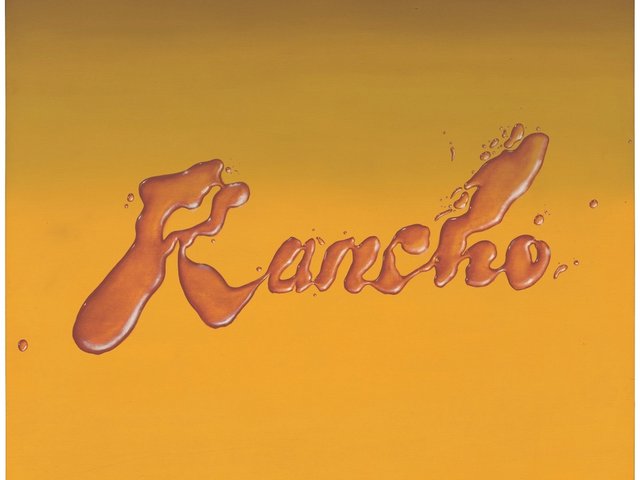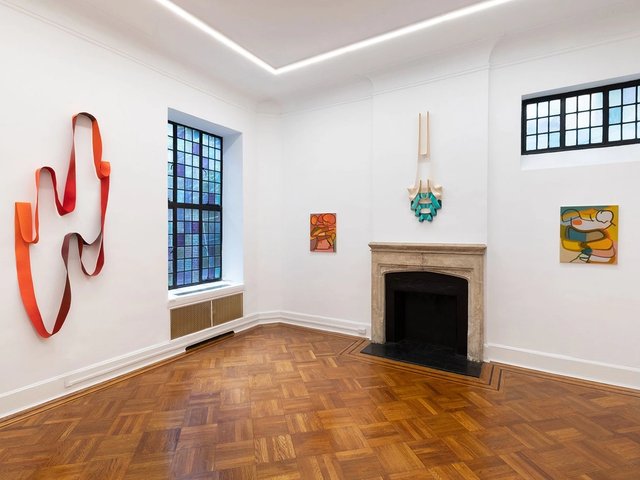If you gather together some paintings and sculptures and arrange them in a gallery the result is an installation, right? Right—but, well, wrong, because within the last thirty years that term has taken on an additional and very specific meaning and is now an art form of its own. Heirs of those early environmental Surrealist exhibitions, of Kurt Schwitters’ walk-in “Merzbau” and more recently and specifically of the Pop artists’ performance experiments and the strewn-rooms of Seventies’ process art, installation artists take as their starting point all the available given space. Their work is site-specific, often interdisciplinary and creates a definite sense of “place”. Presumably nothing can be eliminated from it without changing its meaning.
Indivisibility was certainly an important aspect of Barbara Kruger’s show at Mary Boone gallery three years ago when she decorated all available surfaces—floors, ceilings, walls and even the gallery’s roll-down door—with her characteristic black, red and white typographies and photo blow-ups. To find out whether her latest efforts are equally indivisible get to Mary Boone between 5 March and 30 April.
Kruger is only one of a host (ought one say hostess?) of women artists working today who specialise in all-encompassing art. Carolee Schneemann was a pioneer of the genre and this month, starting on the 19th at Penine Hart, she has devised “Mortal Coils”, a memorial to eleven friends—including John Cage, Hannah Wilke and art world photographer Peter Moore—who died last year. The installation involves wall-mounted texts from newspaper In Memoriam columns, photographs, and eleven ropes casting undulating shadows on the projected slide imagery. The show closes on 16 April. To hear Schneemann discuss her work you need only turn up at the Whitney Museum on 24 March at 6.15 p.m. when she will participate in that institution’s Seminars with Artists series.
Adrian Piper’s recent installations have often confronted viewers with video screens situated in manipulative architectural settings (remember her white room in MOMA’s “Locations” show a few seasons ago?). The beginnings of her involvement with the notion of enveloping space are laid out at Paula Cooper’s 149 Greene Street space (from 3 to 26 March) in her “Hypothesis Series”, a photo investigation of surroundings and self made between 1968 and 1970. Piper considers it a bridge between her earlier conceptual efforts and the more politically-charged recent work.
At 303 Gallery Kristin Oppenheim surrounds the visitor with nothing more—and nothing less—than sound (from 12 March to 12 April), while the French-Canadian Genevieve Cadieux has installed “Blind Love” at Kent (5 March-30 April). It includes cibachrome prints of her mother’s eyes and lips and a bronze of her arm.
Sherrie Levine may not qualify as an installation artist but who can say that her latest creation, “Newborn”, as arrayed last autumn in the great staircase hall of the Philadelphia Museum of Art, is not installation art? For “Newborn” consists of a dozen aligned grand pianos acting as bases for as many matt-finished glass casts of Constantin Brancusi’s eponymous 1915 marble ovoid. (The Philadelphia Museum has owned the Brancusi since it arrived with the Arensberg Collection in 1950). This month Marian Goodman has managed to squeeze six of them into her 57th Street gallery (until 26 March).
While in residence recently at Philadelphia’s unique Fabric Workshop (it has been the unsung facilitator of many an artist’s dream) Renée Green amended some traditional eighteenth-century French toile designs to include images that refer to events from our own time (it turns out that the manufacture of toile itself has an unexpectedly political history). In her installation at Pat Hearn she has used this fabric to cover various pieces of furniture. The walls are papered to match (5 March-13 April).
The natural history and ethnology of an invented, island people—the Ho—are presented, in miniature, by Svetlana Martinchik and Igor Stepin at Ronald Feldman from 5 March to 2 April. First shown last autumn at the Guelman Gallery in Moscow, Martinchick’s models depict the people, architecture, and characteristic occupations of a world in the midst of a Golden Age. An extensive catalogue details the story of this imaginary society.
Chris Burden—at Gagosian downtown and at 65 Thompson Street until 26 March—has also put tiny people to work. His are small tin soldier types, busy recreating “America’s Darker Moments” (among them the assassination of J.F.K. and a prototypical lynching). Two other pieces in the show are “Small Guns” and “L.A.P.D. Uniform”. Mario Merz installs recent work at Barbara Gladstone between 12 March and 2 April and Carter Kustera presents “Consciousness”, an installation further exploring his concern with the psychology of vision. The show, at Josh Baer from 12 March to 19 April, includes mirrors with texts on them. One of them says “I have seen that look in your eye before”.
The team of Peter Fischli and David Weiss—famous as the heirs of Rube Goldberg for the wittily moving parts in their film “The Way Things Go”, present new sculptures and videos at Sonnabend between 19 March and 16 April and new sculptures by Leonardo Drew are at Threadwaxing Space and Barbara Toll (12 March-23 April and 5 March-9 April respectively).
A few portraits by the meticulous William Bailey are included in his show at Emmerich from 3 March to 9 April. One, “Portrait of S.” is from 1964 (lent by the University of Virginia Museum) and another, “Portrait of N.” is from 1980 (lent by the Whitney Museum). They help give a sense of background to his most recent production.
If Bailey’s figures seem well behaved, even demure, John Wesley’s are often quite naughty. The precise interaction of two female nudes in a painting in his current show at Jose Freire was better left undescribed by the gallery (until 26 March). The grand master of the naughty nude—naughty though ridden with angst, of course—was the Viennese Egon Schiele. To coincide with the National Gallery’s big Schiele show in Washington (see p.00) Gagosian (uptown) has mounted “Egon Schiele: Nudes”—works on paper accompanied by a catalogue with essays by the Schiele experts Jane Kallir and Alessandra Comini (10 March-16 April).
Given the resurgence of politicised, expressionistic painting in recent years, you’ld think the art world would be happily awash in a Max Beckmann revival. But that has not been the case. A few seasons ago we had a group of self portraits but there has been nothing until now, when Michael Werner has gathered together a selection of the German master’s paintings and drawings (11 March-9 April).
Richard Bosman—born in India and raised in Australia—surely qualifies as one of Beckmann’s distant progeny. Recently, in addition to painting, he has turned to sculpture. In his show at Brooke Alexander until 25 March, aptly titled “Fragments”, he augments paintings with painted plaster casts of childrens’ limbs, each with a childish abrasion. Descriptive texts accompany the pieces (“splinter”, “rash”, “bruise”).
At P.P.O.W. five women take part in “Untitled”. Beth Haggart, Polly Apfelbaum, Jessica Stockholder, Nancy Rubins and Lauren Szold—unregenerative abstractionists all—make a case for the “good girls” in the face of this month’s “Bad Girls” show at The New Museum of Contemporary Art (until 26 March).
Originally appeared in The Art Newspaper as 'Installations are in'




